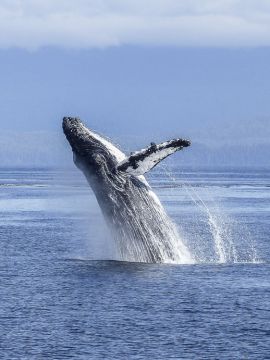Sydney-siders and Melbournians aren’t the only visitors that head north to the Whitsundays when the temperatures drop. From June to September every year, our beautiful warm-watered archipelago welcomes thousands of Humpback whales.
Having journeyed from the icy waters of the Antarctic, Humpbacks come to the comfortable, protected waters of the Whitsundays to give birth and nurture their calves during their first months of life.
While many mysteries still surround the behavior of these playful, gentle giants, if you are lucky enough to join us at InterContinental Hayman Island Resort during the winter months, here are a few fun facts about our annual visitors:

They are seasoned travelers
The Humpback whales’ return migration from Antarctica to the east coast of Australia and back again is one of the longest in the animal kingdom at 10,000 kilometers.
They feed only during one season
Instead of teeth, Humpback whales have baleen, rows of bristly keratin plates that they use to catch plankton, krill and small fish. During their summers in the Anarctic, Humpbacks are said to eat up to 2,500 kilograms of food to create fat stores for their journey to Australia’s East Coast. They do not feed again until they return to the cooler waters after their annual migration.
They are known for their “singing”
Dubbed the “sirens of the sea”, male Humpback whales are known for their distinctive calls, which are often described as haunting sequences of moans and howls. Though scientists are not sure exactly what the purpose of the calls are, some say they are more often heard during mating season to attract females. Another theory is that the long, drawn out calls act as a sonar system, similar to that of a dolphin, so that whales can better navigate through their surrounds.
They are enormous
Not entirely surprising, but Humpback whales can grow up to 18 meters in length (60 feet) and weigh up to 36 metric tons. Their newborn calves average about 3 to 4.5 meters (10 to 16 feet) and weigh up to one ton.

They breach for various reasons
Witnessing a humpback jump out of the water and come crashing back down below the surface can be a spectacular sight, but the reasoning behind breaching is still somewhat mysterious. Most scientists believe that breaching is another form of communication, and whales use the weight of their bodies and fins to speak with nearby pods about food, predators or simply to mark their territory. Another common belief is that whales breach simply to take a look at their surroundings above water. Lastly, and perhaps less supported, is that Humpbacks breach to essentially give themselves a back scratch!
They are a protected species
As a protected species, Marine professionals must follow strict protocol when sailing through the Whitsundays during whale season. Unless approached by a Humpback, boats must not go within 100 metres from a whale in the Great Barrier Reef Marine Park and 300 metres in the Whitsundays Whale Protection area. Drones must not fly below 1000 feet near whales, and helicopters must not go below 1650 feet
Like with any wild animal, there is never a guarantee that you will see Humpbacks when you join us at InterContinental Hayman Island Resort during the whale-spotting season. However, many guests report spectacular sightings during their boat transfers to and from Hamilton or Coral Sea Marina, during snorkeling or on-water excursions, from their ocean-view balconies or during a helicopter or seaplane experience.
Ready to join us for your winter escape to paradise? Explore our special offers or contact our dedicated reservations team.

